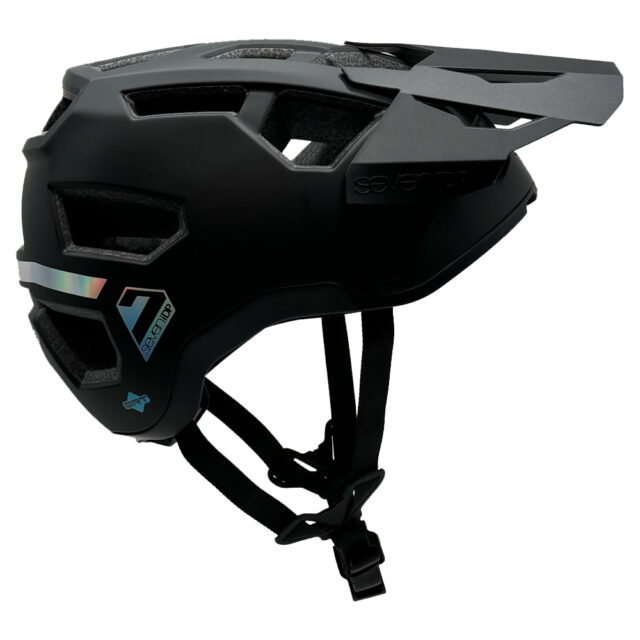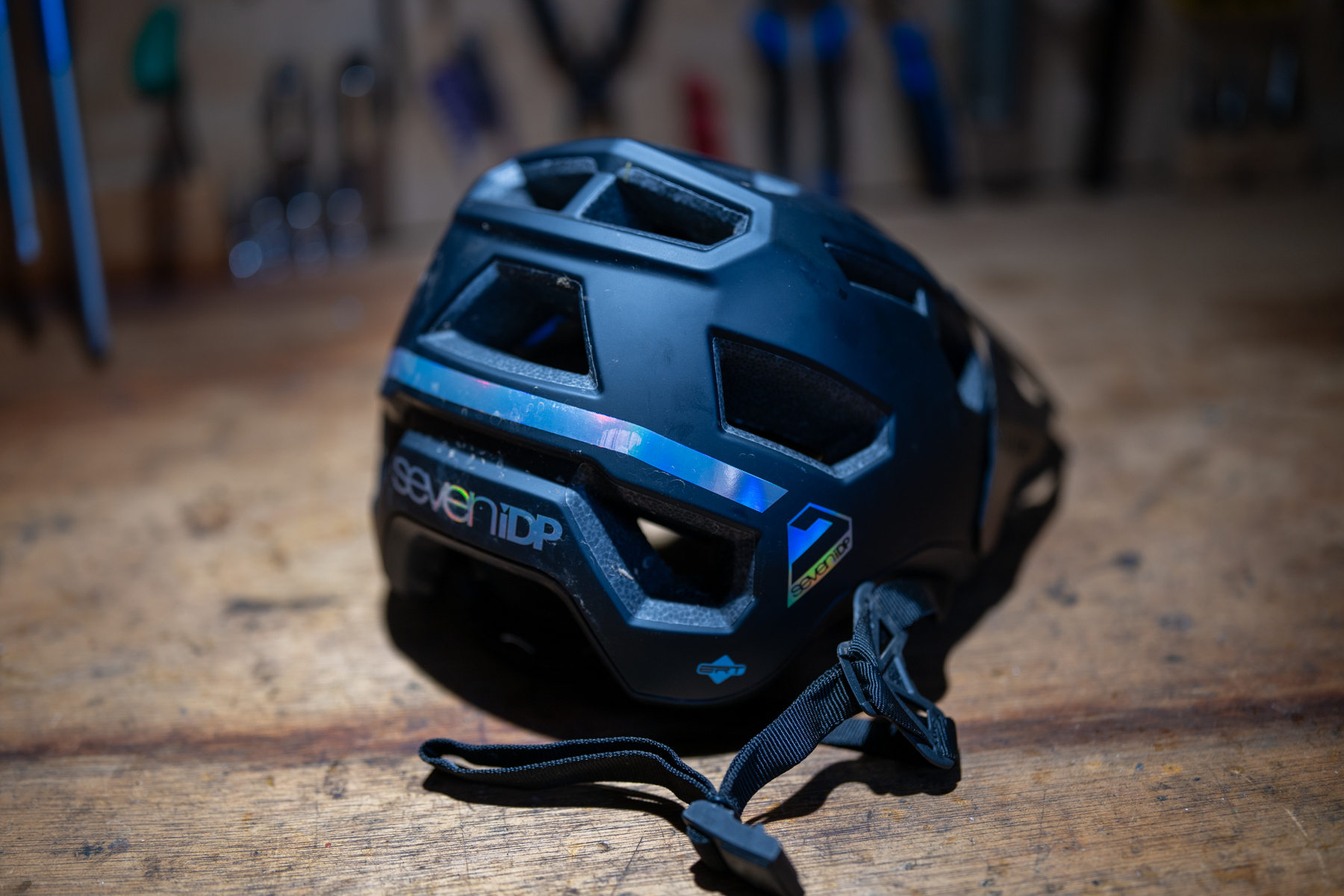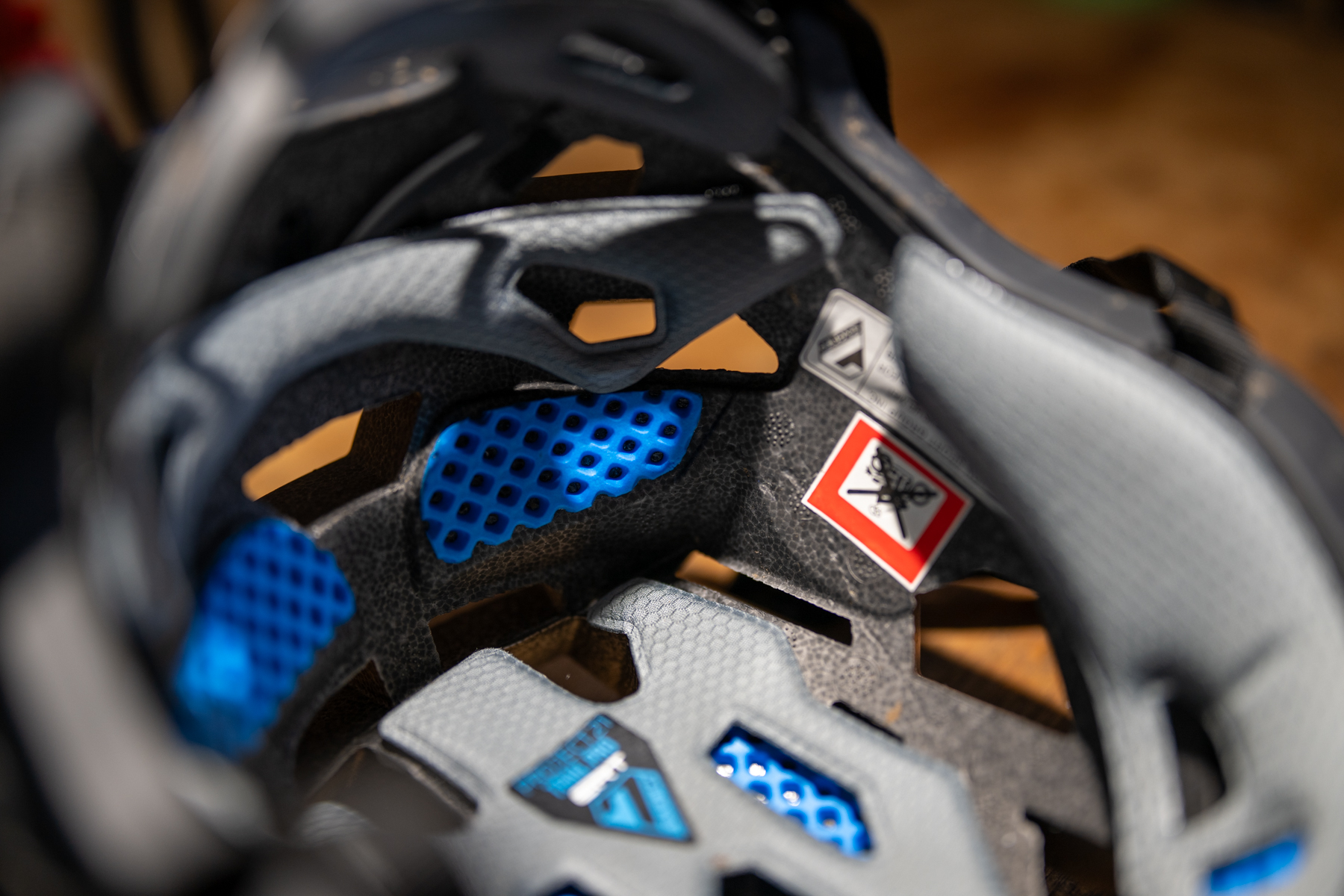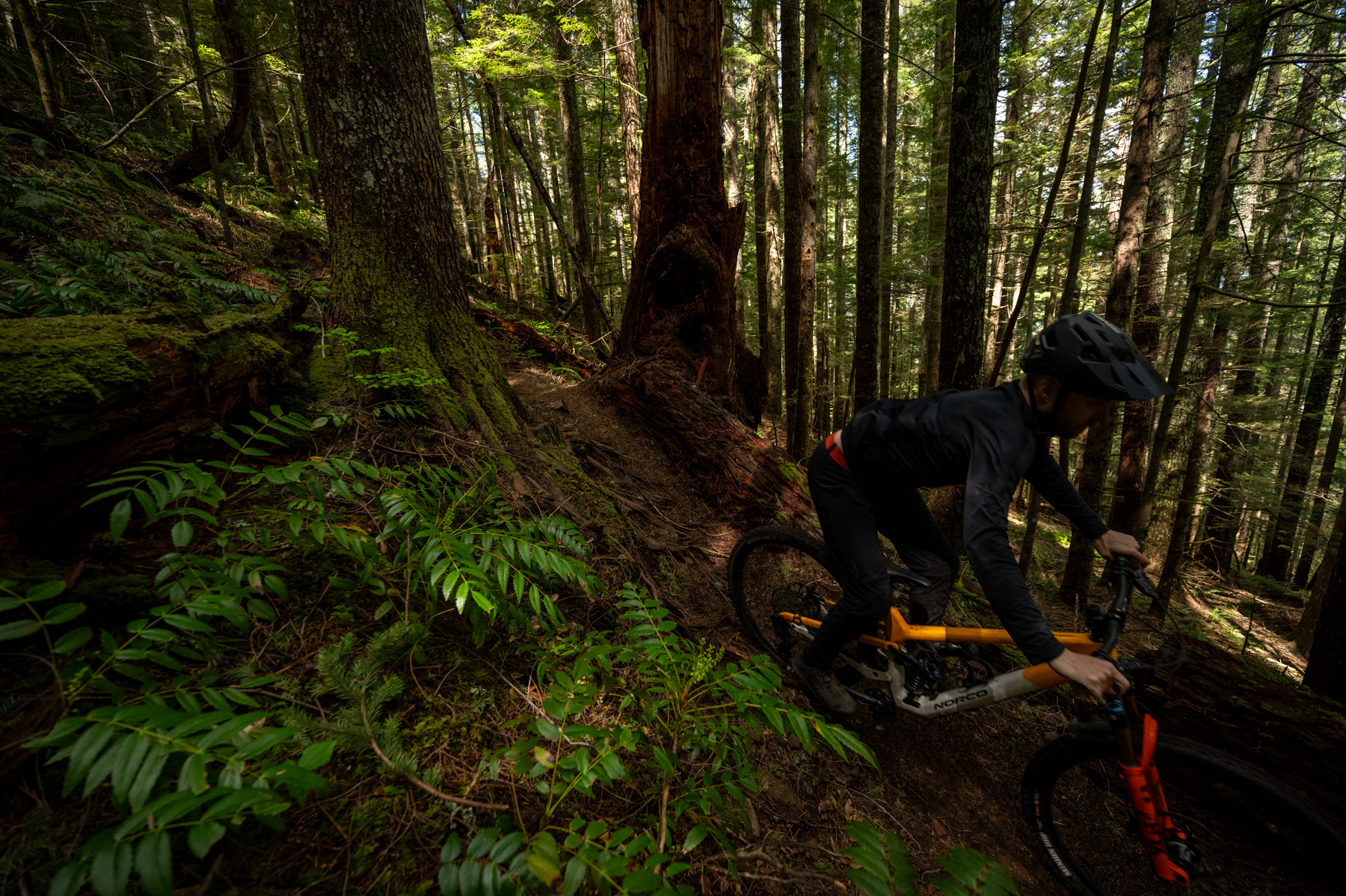7iDP Project.21 Helmet
Size Tested: XL / XXL
MSRP:
- Project.21 Holographic Limited Edition: $230
- Project.21 Pro: ~$190 (available later this year)
- Project.21: ~$150 (available later this year)
Blister’s Measured Weight: 423 g (Size XL/XXL)
Test Location: Washington
Test Duration: 3 months

Intro
7iDP has been making some very good protective gear for a long time now (I’m still a particular fan of the Sam Hill knee pads) but I had yet to try any of their helmets. So when 7iDP told us they were launching a new Trail bike helmet, I was curious to see what they’d come up with.
The new Project.21 is the result, and it’s got some interesting things going on, design-wise — let’s dive right in.
Design & Features
The Project.21 draws its name from the number of vents (there are 21 of ‘em), and what it arguably lacks in creative naming, it makes up for via some interesting features, particularly on the construction and safety front.

The main shell of the Project.21 is made primarily from EPS foam — the same sort of stuff that’s used in most bike helmets — but in a more complex arrangement than most other helmets.
In short, the outer layer of the Project.21’s shell is constructed of EPS with a series of cone-shaped indentations in it; the inner layer is also EPS with cone-shaped protrusions that match those on the outer layer; and there’s a third layer of a softer foam material sandwiched in between them.

7iDP calls the design “Conehead” and it’s designed to help dissipate energy from an impact throughout the shell of the helmet, and in turn, minimize how much is transmitted to the head and brain. It’s a different approach to accomplishing a similar goal as Lazer’s Kineticore technology (which we touch on in our reviews of the Jackal and Coyote helmets, and in Ep.112 of Bikes & Big Ideas with Chris Smith from Lazer).
Conehead is specifically meant to help manage rotational impacts better than a uniform EPS shell, without needing to add a separate MIPS liner that adds plastic, weight, and thickness to a helmet (and that can potentially move, rattle, and otherwise be an irritation).
On top of all that — or rather, under — the Project.21 layers on patches of “Energy Reduction Technology” (ERT) foam. It’s a softer, more rubbery material in a waffle pattern that’s placed on the inside of the shell to help further disperse lower-energy impacts (the blue patches in our photos). The idea is that the ERT material can deform at very low forces to help deal with smaller impacts that a pure EPS liner would transmit more directly; the main EPS shell is there to deal with bigger ones.

Conehead isn’t new in the Project.21 — 7iDP says it’s now in its fourth generation of development — but the Project.21 is my first personal experience with it. From the end user standpoint, it really feels like a normal EPS foam shell, with nothing obviously different or novel going on. The interesting stuff is all happening internally, and while I can’t really asses to what extent Conehead helps on the safety front, it’s a lot less obtrusive than most MIPS liners I’ve tried to date.
Elsewhere, the features of the Project.21 are fairly typical of a higher-end Trail helmet. You get a Fidlock magnetic buckle for the chin strap, dial-style retention system with an adjustable anchor point, breakaway visor with three positions of height adjustment, and two sets of interior pads with differing thicknesses. Those pads also get an anti-microbial treatment to help keep funk at bay.
7iDP is launching the Project.21 with a limited-edition model, which is offered only in black with holographic accents (pictured), for $230, including a very nice padded helmet bag. A “Pro” model will be released later this year, for an estimated $190; that version will be functionally identical to the current Limited Edition one, but in different colors and with a more basic drawstring bag instead of the fancy zippered one. A standard version will also be available later in the year for around $150. The standard Project.21 forgoes the Conehead tech for a single-layer EPS shell and drops the Fidlock buckle for a standard one.

Fit
7iDP offers the Project.21 in three sizes, labeled XS/S, M/L, and XL/XXL; nominal sizing notwithstanding, they roughly correspond to S, M, and L sizes in most brands’ ranges. 7iDP says that the XS/S should fit heads between 52 and 55 cm in circumference (20.5 to 21.75 inches); the M/L covers 56 to 59 cm (22 to 23.35 in); and the XL/XXL is recommended for 60 to 63 cm / 23.75 to 25 inches.
I wear a size Large helmet in most cases (I’ve got a ~61.5 cm / 24.2 in head circumference), and the XL/XXL Project.21 fits me quite nicely. I’d characterize my head as being maybe a little more oval than truly round (i.e., moderately long relative to its width), but it’s rare for a half-shell helmet (in the right size) to truly fit me poorly — my head seems pretty “normally” shaped and easy to work with for the most part.

Even so, the shape of the Project.21 suits me especially well, with one minor exception that we’ll get to in a minute. Everyone’s head is different, of course, but the Project.21 wraps around mine really nicely, feeling especially secure and closely following the contours of my head. The interior padding is ample and comfortable, the dial retention system is nicely adjustable, and the Project.21 is very, very close to being the best-fitting half-shell helmet I’ve tried in quite some time.
The only thing that stops the fit from being perfect on my head is that there’s just not quite enough room for me where the slope of my forehead and the top of my head converge, right around where my hairline would be if I still had much of one. It’s not a major issue — the Project.21 is still pretty comfortable for me overall — but I develop a mildly irritated spot there after a few hours in the Project.21.
But again, everyone’s head is different, and we’d always recommend trying on a helmet before buying one (whenever possible). The Project.21 also isn’t the first helmet I’ve had a similar issue in, so it’s very possible that I’ve just got a more pronounced peak to that part of my head than a lot of folks. In any case, it’s the only minor imperfection for me, fit-wise, in what is otherwise a truly excellent fitting option. Installing the thicker of the two pad options along the lower part of my brow with the thinner one over the crown of my head helps a little, but doesn’t entirely mitigate the problem.

To bring it back around to the overall shape of the Project.21, it feels largely similar to that of the Smith Forefront 2. The Project.21 is a touch more oval-shaped than the POC Kortal Race MIPS, Lazer Coyote, Lazer Jackal, and, especially, the Fox Speedframe Pro; it’s much more oval / less round than the Giro Source and Manifest.
I’d also put the Project.21 slightly on the higher-coverage end of the spectrum for a half-shell Trail lid, especially in how low it sits above the brow. When I first put it on, one of the things that I immediately noticed was that I could see more of the helmet shell at the top of my peripheral vision than I can with most other half-shells; on trail, though, it’s been a non-issue and I haven’t noticed at all. I rarely wear goggles with a half-shell helmet, but I tried a few on with the Project.21 and found that particularly big, tall goggles did push down on my nose a little bit due to interference with the front of the helmet, but more average-sized ones seemed fine.
On The Trail
The Project.21 has generally been unobtrusive and pleasant to ride in. It’s reasonably well-ventilated and on the cooler end of the spectrum for a high-coverage half-shell helmet. The interior padding is ample, with more capacity for soaking up sweat than a lot of other options and, at least on my head, it’s very stable feeling, with none of the wobbly sensations or noise that you can get from certain helmets, especially those with less-dialed MIPS implementations.

I haven’t yet pedaled in the Project.21 in any super hot weather, but I’ve ridden with it in temperatures into the 70s Fahrenheit (~23° C). I’d rank it as being appreciably better ventilated than the POC Kortal Race MIPS and the Smith Forefront 2, in a similar ballpark to the Lazer Coyote Kineticore, and a notch behind the Lazer Jackal Kineticore and Fox Speedframe Pro.
But really, the best thing I can say about the Project.21 is that I’ve never really thought about it while riding. It’s been cool, comfortable, and generally unobtrusive. If only there was a tiny bit more room at the top of the forehead area, it’d be just about perfect on my head. But the Project.21 is a nicely refined, well thought out helmet, and if the fit works for you, it’s a worth a look.
Bottom Line
Helmet manufacturers have been trying a variety of ways to mitigate rotational impacts for a while now, and while MIPS is still the best-known and most common technology meant to help out there, it can sometimes be noisy and introduce obvious movement between the rider’s head and the helmet shell. 7iDP’s “Conehead” design seems like a promising way of achieving similar goals without those downsides. That aside, the Project.21 helmet is a well-thought-out and comfortable Trail helmet that seems like an especially promising option for folks with comparatively oval (i.e., long relative to its width) heads. If that shape works for you, there’s a lot to like here.

Is this or any of the referenced helmets triple certified? I know my Dynafit TLT is. And yeah, fit is important. But I’ve never put on a helmet that didn’t fit right? Maybe I have an overly average head. So anyway, skiing, biking, and climbing cert. should be the industry standard. But I don’t think it is?… I don’t care too much about the tech inside. Never had a MIPS issue, not sure if I have/or have had it in any helmet.